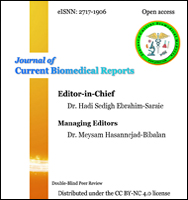Inhibitory effect of Syzygium aromaticum L. and Coffea arabica L. extract on Staphylococcus aureus in vitro and comparing it with selected antibiotics
Abstract
Keywords
Full Text:
Full-text PDFReferences
Petrovska BB. Historical review of medicinal plants' usage. Pharmacogn Rev. 2012; 6(11):1-5.
Foroughi A. A review on medicinal plants; An emphasis on antimicrobial effects. Vet Res Biol Prod. 2022; 35(1):2-17.
Razavi N, Molavi Choobini Z, Salehian Dehkordi M, Saleh Riyahi S, Salehian Dehkordi M, Molavi Choobini S. Overview of the antibacterial properties of essential oils and extracts of medicinal plants in Iran. J Shahrekord Univ Med Sci. 2016; 17(6):41-52.
Fiebelkorn KR, Crawford SA, McElmeel ML, Jorgensen JH. Practical disk diffusion method for detection of inducible clindamycin resistance in Staphylococcus aureus and coagulase-negative staphylococci. J Clin Microbiol. 2003; 41(10):4740-4.
Cowan MM. Plant products as antimicrobial agents. Clin Microbiol Rev. 1999; 12(4):564-82.
Dulger B, Gonuz A. Antimicrobial activity of certain plants used in Turkish traditional medicine. Asian J Plant Sci. 2004; 3(1):104-7.
Shopsin B, Kreiswirth BN. Molecular epidemiology of methicillin-resistant Staphylococcus aureus. Emerg Infect Dis. 2001; 7(2):323-6.
Tong SY, Davis JS, Eichenberger E, Holland TL, Fowler VG, Jr. Staphylococcus aureus infections: epidemiology, pathophysiology, clinical manifestations, and management. Clin Microbiol Rev. 2015; 28(3):603-61.
Marcinak JF, Frank AL. Treatment of community-acquired methicillin-resistant Staphylococcus aureus in children. Curr Opin Infect Dis. 2003; 16(3):265-9.
Majnooni M, Abiri R, Afnanzade NS, Malek Khatabi P. Study of Antibacterial Effects of Hydro - alcoholic Extract of 8 Medicinal Herbs Against Vancomycin Resistant Staphylococcus aureus. J Med Plants. 2012; 11(41):103-10.
Peacock SJ, Paterson GK. Mechanisms of Methicillin Resistance in Staphylococcus aureus. Annu Rev Biochem. 2015; 84:577-601.
Nehlig A. Are we dependent upon coffee and caffeine? A review on human and animal data. Neurosci Biobehav Rev. 1999; 23(4):563-76.
Antonio A, Farah A, Santos K, Maia L. The potential anticariogenic effect of coffee. Science against microbial pathogens: communicating current research and technological advances. 2011. p. 1027-32.
Antonio AG, Moraes RS, Perrone D, Maia LC, Santos KRN, Iório NL, et al. Species, roasting degree and decaffeination influence the antibacterial activity of coffee against Streptococcus mutans. Food Chem. 2010; 118(3):782-8.
Farah A. Coffee constituents. In: Chu Y-F, editor. Coffee: Emerging health effects and disease prevention. First Edition ed. Published 2012 by Blackwell Publishing Ltd: John Wiley & Sons; 2012. p. 22-58.
Farah A, Monteiro MC, Calado V, Franca AS, Trugo L. Correlation between cup quality and chemical attributes of Brazilian coffee. Food Chem. 2006; 98(2):373-80.
Almeida AA, Farah A, Silva DA, Nunan EA, Glória MB. Antibacterial activity of coffee extracts and selected coffee chemical compounds against enterobacteria. J Agric Food Chem. 2006; 54(23):8738-43.
Kamatou GP, Vermaak I, Viljoen AM. Eugenol--from the remote Maluku Islands to the international market place: a review of a remarkable and versatile molecule. Molecules. 2012; 17(6):6953-81.
Nzeako BC, Al-Kharousi ZS, Al-Mahrooqui Z. Antimicrobial activities of clove and thyme extracts. Sultan Qaboos Univ Med J. 2006; 6(1):33-9.
Nascimento GG, Locatelli J, Freitas PC, Silva GL. Antibacterial activity of plant extracts and phytochemicals on antibiotic-resistant bacteria. Braz J Microbiol. 2000; 31(4):247-56.
Tshabalala R, Kabelinde A, Kaptchouang Tchatchouang CD, Ateba CN, Manganyi MC. Effect of Clove (Syzygium aromaticum) spice as microbial inhibitor of resistant bacteria and Organoleptic Quality of meat. Saudi J Biol Sci. 2021; 28(7):3855-63.
Moon SE, Kim HY, Cha JD. Synergistic effect between clove oil and its major compounds and antibiotics against oral bacteria. Arch Oral Biol. 2011; 56(9):907-16.
Isenberg HD. Clinical microbiology procedures handbook. American Society of Microbiology. 2004. p. 10-57.
Bauer AW, Kirby WM, Sherris JC, Turck M. Antibiotic susceptibility testing by a standardized single disk method. Am J Clin Pathol. 1966; 45(4):493-6.
Nazari M, Pakzad I, Maleki A, Hematian A. Comparison of in vitro inhibitory effects of different extracts of Scrophularia striata plant on Staphylococcus aureus, Pseudomonas aeruginosa and Helicobacter pylori. J Ilam Univ Med Sci. 2014; 22(3):67-72.
Wayne P. Clinical and Laboratory Standards Institute: Performance standards for antimicrobial susceptibility testing: 20th informational supplement. CLSI document M100-S20. 2021.
Hoekstra J, Rutten V, Lam T, Van Kessel KPM, Spaninks MP, Stegeman JA, et al. Activation of a Bovine Mammary Epithelial Cell Line by Ruminant-Associated Staphylococcus aureus is Lineage Dependent. Microorganisms. 2019; 7(12):688.
Monadi M, Motamedi H, Sanei N. The effects of ethanol and methanol extracts of Ziziphus spina-christi, Peganum harmala, Salvia officinalis, and Querqus brantii on the growth and biofilm formation by Staphylococcus aureus in vitro. Qom Univ Med Sci J. 2021; 15(7):482-9.
Daglia M, Papetti A, Grisoli P, Aceti C, Spini V, Dacarro C, et al. Isolation, identification, and quantification of roasted coffee antibacterial compounds. J Agric Food Chem. 2007; 55(25):10208-13.
Mazaher Ghorbani M, Ahmady-Asbchin S. Evaluation of Antibacterial Properties of Coriander, Oregano, Fennel, Thyme and parsley extracts, on Pathogenic Bacteria Staphylococcus aureus (ATCC 33591) , Escherichia coli (ATCC 23591) , Klebsiella (ATCC 10031) and Salmonella Typhimurium. J Sabzevar Univ Med Sci. 2018; 25(4):591-8.
Rahman NA, Muharram SH, Abiola O. Antibacterial activity of NESCAFÉ instant coffee beverages and pharyngitis-causing Streptococcus species. Brunei Darussalam J Health. 2014;5:70-9.
Safahani A, Ataie M, Rabie M, Dadgar T, Ghaemi E. Comparison of antibacterial activity of some of the medical plants extracts of Golestan province against Staphylococcus aureus. J Med Herb. 2011; 1(4):41-51.
Hughes BG, Lawson LD. Antimicrobial effects of Allium sativum L.(garlic), Allium ampeloprasum L.(elephant garlic), and Allium cepa L.(onion), garlic compounds and commercial garlic supplement products. Phytother Res. 1991; 5(4):154-8.
Karaman S, Digrak M, Ravid U, Ilcim A. Antibacterial and antifungal activity of the essential oils of Thymus revolutus Celak from Turkey. J Ethnopharmacol. 2001; 76(2):183-6.
Refbacks
- There are currently no refbacks.
Copyright (c) 2023 © The Author(s)

This work is licensed under a Creative Commons Attribution-NonCommercial 4.0 International License.













